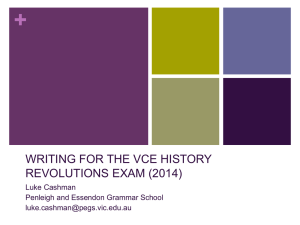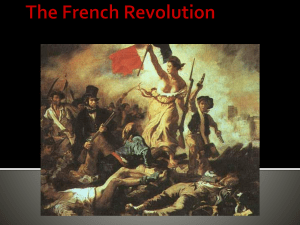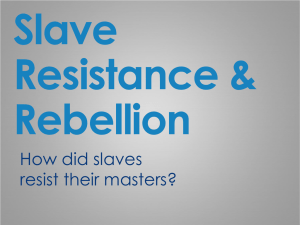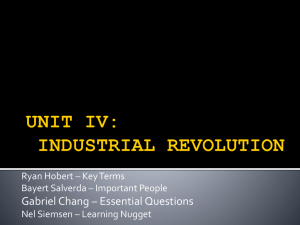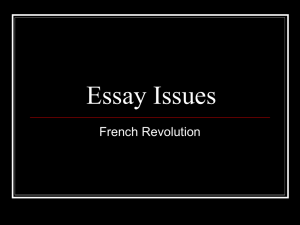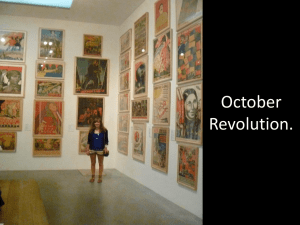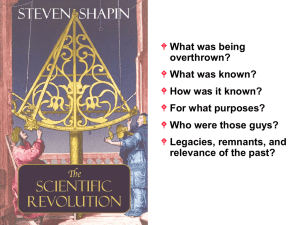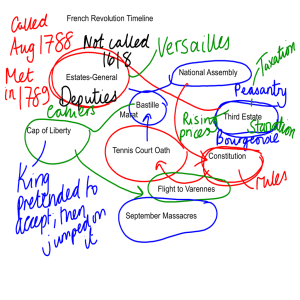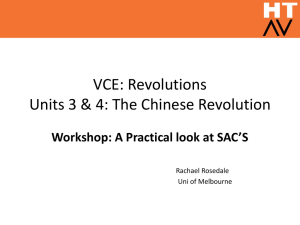Answer the question
advertisement
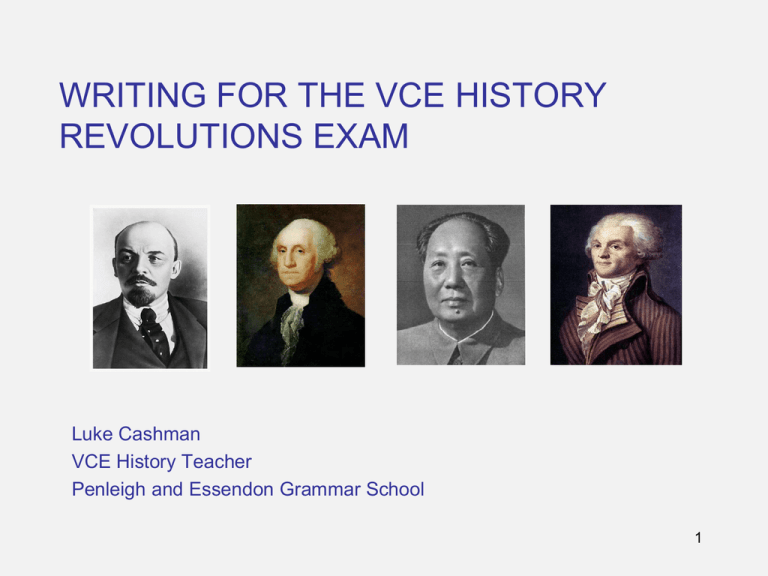
WRITING FOR THE VCE HISTORY REVOLUTIONS EXAM Luke Cashman VCE History Teacher Penleigh and Essendon Grammar School 1 What will be covered today? • • • • • • • • • Structure of the exam Exam format: question booklet & answer booklet Time allocation Which Revolution for which Section? How to address particular questions Sample student responses Preparation and study advice Study resources General hints and tips 2 Structure of the examination • Wednesday, 14 November 3.00 - 5.15pm • The exam is worth 50% of your overall result for this subject • Total of 80 marks • 15 minutes reading (and thinking) time • Two hours writing time • Two Sections (A & B) which contain two Outcomes each: – Outcome 1: Movements, Ideas, Leaders and Events – Outcome 2: Creating a new society 3 Section A & Section B • Each Section is worth 40 marks; each Outcome is worth 20 marks • Therefore 60 minutes per Section; 30 minutes per Outcome • Roughly 500 words per Outcome every 30 minutes • You must nominate which Revolution you will address on the front page for both Sections in the Answer book • You can only write on ONE revolution in each Section. Eg: – Section A: America (both Outcomes) – Section B: China (both Outcomes) 4 Exam format • • • • • • • • Separate Question and Answer book In the past, these were combined Facilitate computer scanning for assessment Hopefully prevent problems over which Revolution to write on in each Section Each Outcome immediately follows on from the previous one in each Section You MUST write your responses in the appropriate place in the Answer book Use extra space provided appropriately – clearly label your responses Do not use pencil; blue or black pen only 5 Which Revolution to write on for Sections A and B: • Which Revolution can you write on in both Sections? • Which Revolution should you write on? • Two options: – Decide in the exam room after you have read the questions – Decide prior to the exam, regardless of the questions • If you take the latter option: – Decide early so that you reduce your preparation time – Think about the SACs you sat during the year – For example - France: SAC 1 Document Analysis; SAC 2 Argumentative essay… corresponds to Section B 6 SECTION A REVOLUTION ONE 7 Section A, Outcome 1 (I) • Indicate which Revolution you are addressing in the Answer book • Movements, ideas, leaders and events that contributed to the Revolution • Long-term, structural factors such as: social, economic and political causes • Short-term precipitants: wars, financial crises, signs of weakness at the top etc. • Question format: Short Answer • Two questions; BOTH must be answered • 10 marks each; 15 minutes per question • This includes >1 minute planning each • Approximately 250 words per question • Address these questions in the appropriate section of the Answer book 8 Section A, Outcome 1 (II) • Read the question carefully and underline/highlight key terms • Stay within the timeframe given in the question (eg: “between February and October 1917”) • The first sentence must answer the question directly • “A successful answer requires about four different relevant points.” (Exam advice for Revolutions, The Age, 12.9.11) • Use signposting to connect or differentiate between your points (eg: firstly; secondly; thirdly; finally) • Include specific detail: groups & movements; individuals; key events (dates); the impact of ideas and ideologies; policies and documents/speeches • Historians’ views NOT required (Assessor’s Report on the 2011 Revolutions exam) 9 Section A, Outcome 1 (III) • Focus: explain “how” a movement, leader, idea or event “ contributed to the development of a revolutionary situation”, or “explain their importance/significance” • Use words that highlight causal role of an event, person etc: ‘catalyst’, ‘highlighted’, ‘intensified dissatisfaction’, ‘polarised’, ‘popularised’, ‘articulated’, ‘stimulated; ‘led to’, ‘contributed to’, ‘crucial factor in.’ • How and why key social groups (including the armed forces) withdrew their support from the regime • What mistakes or errors were made by the old regime (eg poor decisions; failed attempts at reform; increased political repression; weak leadership) • How and why particular political groups or parties (eg the Bolsheviks or the CCP) were able to muster and maintain sufficient support 10 Section A, Outcome 2 (I) • • • • Creating a new society The same Revolution that you wrote on in Outcome 1 Follows on directly from Outcome 1 - easy to find Key areas to focus on: – What were the aims and goals of the revolutionaries? – Did the Revolution fall short of its goals? If so, why? – Challenges/obstacles/crises: military, political, social and economic – Responses: disproportionate and brutal OR necessary and appropriate? – Change and continuity: was the new regime markedly different to the one it replaced? • Task format: Document Analysis • 1 document; 30 minutes (including planning) 11 Section A, Outcome 2 (II) • “ The part of the paper that has proven most challenging… ” (Chief Assessor, The Age, 9 September 2009) • Can be any of: document, commentary, visual representation or interpretation • Primary or secondary; visual or written • Four questions (a, b, c & d) • Questions a and b: short comprehension / knowledge questions: – – – – 2 marks each Your ability to interpret the extract Be succinct but answer the question Read the questions carefully and get them right! 12 Section A, Outcome 2 (III) Question c: •Knowledge/understanding; historical context surrounding the extract. •Key phrase in the question: “ By quoting from the extract and using your own knowledge… ” or “By referring to parts of the graphic…” •Meet this requirement by quoting directly from the extract or describing an element of a visual representation. •Useful phrases: “As stated in the extract…” or “As Chairman Mao has written here…” or “As can be seen in the visual…” 13 Section A, Outcome 2 (IV) Question c: • Read the question carefully & highlight key terms • Do not simply write a narrative of events • The first sentence should answer the question (a topic sentence) • Expand on this with three main ideas • Use signposting to connect, or differentiate between, ideas • Use specific historical knowledge (dates, names etc) • Stay within the time frame of the question • About 10 minutes • Approximately 150 words • Address this in the appropriate section of the Answer book 14 Section A, Outcome 2 (V) Question d: • Evaluate the usefulness or reliability of the document • This means three things: – Know what event or issue the document refers to – Understand whose perspective is being presented – Know what others have said about that event or issue (can be contemporary views or historians) • Read the question carefully and underline key terms • Plan before you write; decide how reliable or useful the document is in representing a specific episode of the past and be prepared to explain your answer • You MUST stay within the time frame of the question 15 Section A, Outcome 2 (VI) Question d: •Your first sentence must answer the question (ie: how reliable or useful is the source: extremely; quite; somewhat; limited etc) •Discuss the strengths and/or limitations of the source; refer to obvious bias or deliberate distortion if evident •Omission – what aspect of the event or issue does the document not discuss (ie other causes or consequences) •Quote written documents or describe a particular element of a visual source •Discuss viewpoints that agree with the extract (if possible) •Discuss viewpoints that disagree with the extract •It is not enough to list schools (eg: Marxists; revisionists); you need to know what particular historians have argued about specific aspects of the revolution 16 Section A, Outcome 2 (VII) Question d: •Top students are now starting to quote historians (Assessor’s Report on the 2010 Revs exam) •Use well-known historians •Use signposting throughout to indicate where viewpoints differ or concur (Similarly; on the other hand; in addition; however) •Summarise your findings in the final sentence; link back the question directly •Eg: “Therefore, this extract is of limited use because…” •Approximately 250 words •15 minutes •Address this in the appropriate place in the Answer book 17 SECTION B REVOLUTION TWO 18 Section B, Outcome 1 (I) • Remember that you must write on a different revolution from the one you referred to in Section A • Mark this in the appropriate place in the Answer book • AOS 1 - Movements, Ideas, Leaders and Events • The task in Section B, Outcome 1 is essentially the same as Section A, Outcome 2 • Document analysis: Any of a document, commentary, visual representation or interpretation • Format: a, b, c & d • 20 marks; 30 minutes including planning • Address this in the appropriate place in the Answer book 19 Section B, Outcome 2 (I) • Refer to the same revolution as you did in Section B, Outcome 1 • AOS 2: Creating a new society • Format: Argumentative Essay • ONE essay question per revolution - no choice given as in past exams • Questions are specific to one of the four revolutions • Accompanied by a quote from a participant or historian, or a general statement • This could help you engage with the broader debates on the Revolution 20 Section B, Outcome 2 (II) • Read the question carefully • Highlight/underline the key words • Write a brief plan to structure and organise your response • If a change and continuity question, only minimal reference to AOS 1; otherwise, none at all • 20 marks; 30 minutes • Argue a clear, strong contention that refers directly to the question • Develop a complex contention; avoid simply agreeing or disagreeing with the question (eg. some goals met; not all) 21 Section B, Outcome 2 (III) • Use paragraphing with clear topic sentences • Expand on topic sentences with relevant and specific evidence: – – – – – – policies or speeches key documents key events statistics and quotes important individuals, institutions & groups accurate dates • Historians’ views can be included but they should be used to support your ideas, not as evidence • If you do use them, they should be used to support evidence or arguments rather than in the place of them 22 Section B, Outcome 2 (IV) • • • • Approximately 500 words Brief intro and conclusion (about 50 words each) Three body paragraphs of about 150 words each Three types of questions: – Aims and goals – Crisis and response – Change and continuity • Can focus on any of: – Political – Social – Economic 23 Section B, Outcome 2 (V) Suggested essay structures: 1. Social; economic; political – Aims and goals style questions – Change and continuity style questions 2. Moderate; radical; moderate – Aims and goals style questions – Change and continuity style questions 3. Military; political; social; economic – Crisis and response style questions 4. By social group (eg: nobility; bourgeoisie; urban workers; peasants; the very poor) – Social aims and goals or change and continuity style questions 24 Section B, Part 2 (VI) Sample Intro: Russia [November 1917 – 1924 death of Lenin] ‘The New Economic Policy was an absolute compromise of Bolshevik ideals and illustrated Lenin’s desire to maintain power for power’s sake.’ Do you agree with this view of the Bolshevik revolutionaries? Use evidence to support your answer. [HTAV Sample exam 2009] By the time of Lenin’s death in 1924, the Bolsheviks had compromised most of their revolutionary goals. This was undoubtedly due in part to the Bolsheviks’ desire to establish a dictatorship and destroy their political opponents. Socially and economically, however, the Bolsheviks were forced (by circumstances largely beyond their control) to implement policies that betrayed their most deeply cherished aims. (60 words) 25 General hints and tips I • • • • • • • Neat hand-writing!!! Write within the designated space on the page Use blue or black pen; no pencil Answer the question Use signposting Use reading time well (also thinking time) Respond to long written documents first OR the revolution you feel most confident with • Be time-disciplined in the examination • Genuine practice examinations completed under examination conditions (e.g. time) 26 General hints and tips II • Get accustomed to the layout and format of the exam (VCAA samples and past exams; HTAV; Insight) • Responding to the right question in the right part of the Answer book • Use specific facts and information • Avoid vague remarks like: “met the needs of the people” or “made the French happy” • Read the captions accompanying documents carefully • Spell and use the terms “bias” and “biased” properly • Something is not biased or unreliable because it is a primary source • Something is not useful or reliable because it is a secondary source 27 General hints and tips III • Roughly 500 words per Outcome. • It’s a matter of words, not how many lines you fill • If you use the extra space in the Answer book, use the correct area and clearly label your continued response • If you use a second Answer book, indicate this CLEARLY • Know the chronology of key events and dates • Understand the chain of cause and effect • Be able to work backwards chronologically from an event so you can discuss causes • Speak to your teacher as often as possible • Read, read, read • Write, write, write 28 Preparation resources I • • • • • • • Past and sample VCAA exams on the VCAA website Assessor’s report Both available at the VCAA website 2010 exam is the best Prior to 2005 are NOT useful at all HTAV and Insight practice exams Erikson & Kerr, VCE Revolutions Teacher Pack (HTAV, 2010) • Chief Examiner’s advice in “The Age” (eg. 12 September 2011) 29 Preparation resources II For historiography: • Textbooks o Cambridge series: “Analysing…” (not America) o HTAV series (eg. “Liberating France”) o Access to History series • Cambridge Checkpoints 2010 • Past examinations • Borrow one or two key works by noted historians 30 The exam won’t test all you know, but you have to know all it tests. 31


